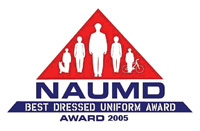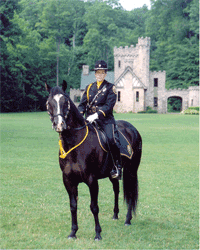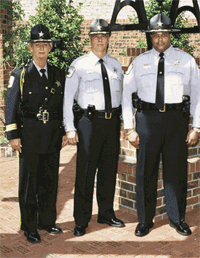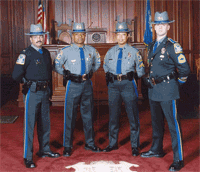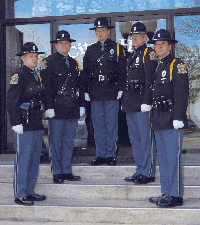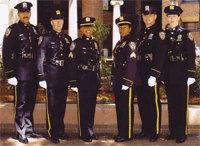|
By Donna J. Pierson,
Director of Marketing & Communications, NAUMD
and Carol Brzozowski, Freelance Writer
When Sheriff Terry Johnson was elected in December 2002 to head up the Alamance County Sheriffs Department in North Carolina, Major Ron Parrish also came on board and immediately began to survey the departments uniforms.
They found officers wearing a standard sheriffs brown uniform, the majority of which had been issued dozens of times.
I went into the uniform room when I first came in here and thought, Theres no way in the world Id put anything like that on me, Parrish says. If Im not going to wear it, I certainly wouldnt expect the deputies to wear it.
The thing that really got me was when one deputy asked for a pair of shoes because the shoes he was wearing had holes in them, and hed been wearing them for about six months, Parrish adds.
The uniforms were thus changed to a blue/grey/black grouping, and the department responded with renewed energy.
Parrish knew of the Best Dressed Law Enforcement Department competition sponsored by the National Association of Uniform Manufacturers and Distributors (NAUMD) and told Johnson he was going to enter it and they would win.
Indeed, they did. Alamance County Sheriffs Department is one of five law enforcement agencies that took the best dressed honor for 2004. The other agencies are the New York City Police Department, New York, for Best Dressed City with more than 200 officers; Bluffton Police Department, Indiana, for Best Dressed City with fewer than 200 officers; Connecticut State Police, Connecticut, for Best Dressed State Agency, and the Cleveland Metropark Rangers, Ohio, for Best Specialized Agency.
All law enforcement agencies throughout the United States are eligible to participate. Judges consider professional appearance, uniform diversity and attention to detail. Various police details require different uniforms, so judges also consider how the uniform fits the job function.
Attention is paid to overall uniform appearance, neatness, proper fit and the publics immediate recognition of the uniform to the law enforcement officer.
When I got the call from the National Association of Uniform Manufacturers and Distributors, I couldnt believe it, says Parrish. When I got the letter informing us, we had a toast.
There was much to celebrate.
We decided that since we had a new sheriff, we wanted a new look, we wanted to be more progressive, we wanted everybody to know that we had a renewed vigor within this agency, and we wanted the public to feel it, says Parrish.
The department considered different uniform styles and colors and surveyed the deputies for their preferences.
The fabrics of the uniform are washable polyester and wool materials for the shirt and trousers. The grey dress shirt with matching pleated breast pocket and dark navy tie tacked with the sheriff star is paired with dark navy trousers featuring a one-inch black leg stripe.
The uniform also features a high-gloss leather duty belt, holster, boots and straw black campaign hat with the sheriffs star.
The Class A uniform has a long jacket with gold braiding at the shoulder, gold rank sleeve stripes and a one-inch gold stripe flanking the dark navy trousers. The Class B dress uniform features an Ike-style jacket in dark navy cut to the waist and trimmed with gold rank sleeve stripes.
This new look is landmark for an historic Sheriffs Department, which was founded in 1849 and currently serves more than 130,000 people with 132 officers.
Its improved the overall morale, Parrish says of the uniforms. In the past, a deputy would start to work and would wind up getting somebodys hand-me-downs and get them altered.
Most people dont want to go to Goodwill to buy clothes, and essentially thats what most of these guys felt like. We had a few actually buy their own rather than come in and ask for anything.
The new look is more professional, and the officers have responded positively.
So, too, has the public. Parrish tells of several occasions where officers respond to a call in the community and get a compliment on their uniform.
The uniform is under ongoing inspection, starting with roll call when deputies report for work.
And that work is not much different from law enforcement officers jobs elsewhere, Parrish notes.
The patrol division has 50 officers whose calls range from barking dogs to homicides. A civil unit serves legal papers, such as subpoenas and eviction notices. The narcotics unit handles illegal drug matters and other vice-related crimes. There are K-9 officers on standby with police dogs for such duties as narcotics detection.
The sheriffs emergency response team handles matters such as barricaded suspects. The department also provides courthouse security for judges and court personnel.
When hiring an officer, Parrish says management favors those who have been through basic law enforcement training, have experience and are mature.
A lot of times, our deputies are out there anywhere in the 428 square miles, and they may be called on to do a lot of things by themselves, Parrish notes. Their closest backup might be 30 to 45 miles away from them.
Parrish says the uniform honor has brought his department a national recognition it has never previously enjoyed. The department is even getting e-mails from other sheriffs offices as far away as Oregon asking about the uniform manufacturer.
Parrish keeps up with law enforcement articles that address the matter of uniforms and points out that various uniforms have different effects on the public.
The bottom line is a number of agencies throughout the country have experimented with different types of uniforms, even going away from the traditional and getting into more of a blazer and a pair of slacks, he says. But most of them are getting back to the standard police uniform, and the ones that are probably the most appealing to the public are the darker pants and lighter colored shirts.
The public demands of police officers that they do that for which their job calls, Parrish points out.
If you have a deputy who comes to the door and is in a nice-looking uniform that is clean and nicely tailored, theres a perception that he obviously knows what he is doing.
Our new look projects a more professional image. This has resulted in a renewed sense of pride and confidence among our deputies, he adds. We feel a professional appearance enhances our image in the public to promote a more secure feeling among the citizens we serve in our community. It also shows our deputies how we feel about them they should be dressed with the best quality uniforms and materials. We trust it also promotes a respect for law enforcement officers and laws in general.
Meanwhile, in Bluffton, Indiana, where the police department dates to 1851 when the officers were paid night watchmen, the force now has 20 officers on staff whose job descriptions span a variety of functions including honor guard, bike patrol and K-9 units, all of which have their own uniforms.
Chief of Police Tammy Schaffer says her officers take pride in their appearance.
Trust and respect are gained when we present a professional image, she says of the award-winning department. The officers make suggestions regarding the choice of uniforms and what they feel sets them apart from other agencies.
Bluffton also adheres to uniform standards outlined in the departments standard operating procedures.
One goal is to differentiate from other local agencies in our appearance while maintaining a professional appearance that is still user-friendly and efficient for the various tasks different police work entails, she says.
Schaffer says her department has six different uniforms, which includes a French blue administrative uniform with a navy blue stripe, and a navy blue blouse or jacket that she and her deputy chief wear.
Area businesses donated the money necessary to purchase the honor guard uniforms. The honor guard appears at funerals, parades, basketball games, flag ceremonies and other functions.
The uniform is comprised of a blue color combination: French blue trousers have a side stripe in navy blue, flanked by grey stripes and a dark navy single-breasted long jacket punctuated with silver buttons.
A jacket is combined with a dark navy shirt, French blue tie and gold shoulder braid to display a serious look for the officer. There also is a polished leather duty belt, holster, shoulder harness and silver shield.
A patch, designed by the department, and an American flag are positioned on the shoulders. The outfit is completed by a black felt campaign hat, badge, braids and white gloves.
A community agency called Citizens Against Drug Abuse helped to raise the funds necessary to purchase Blufftons bike patrol uniforms.
The bike patrol wears summer and cool weather uniforms as they patrol city parks, schools and the Bluffton Street Fair each September.
The public has responded favorably to the look, Schaffer says.
That look includes navy blue work pants that can be unzipped mid-thigh to transform into shorts paired with a dark navy polo shirt and a color-blocked navy and French blue windbreaker/rain jacket.
Between the color-blocking areas of the jacket is reflective tape to keep the bike officers safe. Badges are pinned to the jackets and a nylon duty belt completes the look.
Regular patrol officers are donned in navy street-gear duty pants worn with either dark blue summer or winter shirts. During the winter, officers have the option of wearing a dark blue or black mock turtleneck or French blue tie.
A white crew neck is required when wearing the summer shirt. Boots or shoes are fashioned of black leather. The black campaign hat (felt for winter and straw for summer) is worn with braids and the department badge.
Additionally, all shirts and jackets display the department patch on the left shoulder and the American flag on the right shoulder, with the required officers insignia, nameplate and badge on all shirts.
The K-9 officers wear a durable navy blue pants and a navy blue shirt. There are no badges or buttons; rather, the uniform has a cloth badge, and the officers name is engraved on the side.
For public appearances or courtroom visits, the officers are asked to wear a dressier uniform.
Most of the uniforms are a polyester-cotton blend.
Bluffton has had the uniforms for some time but won the contest for how they convey a professional look and fulfill the needs of the job description, such as bike officers versus the honor guard officers.
Schaffer says there are no uniform inspections, but once a year, the sergeants are asked to determine whether the officers need to be replacing parts of the uniform.
The officers patrol a city with fewer than 10,000 citizens.
Seven years ago, we went through a hiring phase after we lost a couple of people who retired, and we now have a young department of 18 males and two females, Schaffer says. For as small as we are, we have a lot of diversity as far as job description of the officers.
For instance, an officer might serve as an honor guard member as well as a bike patrol officer. An officer also has many specialties within their job descriptions, such as a K-9 officer.
For as small as we are, I think we are one of the most professional departments in the state, Chief Schaffer says. Im really pleased with and proud of our officers. They do an excellent job. In fact I recently e-mailed one of them, telling him I appreciate the extra effort he went to in a particular report.
They really feel like this is their community and they are a part of it. Instead of just responding to things, we have really pro-active officers. They try to get ahead of the problem.
Thats due in part to the standards the department places on the officers it hires.
In new applicants, we ask they have either three years in law enforcement experience or a two-year degree, Schaffer says. Theres a law enforcement ethical code of conduct our people take pretty seriously they talk about being professional, not only on duty but off duty.
What is exciting about law enforcement is that an officer never knows what the day will bring, Schaffer says.
Sometimes its good, and sometimes its bad, but its always different, she says. In a small community like ours, we have the opportunity to do a little more than some of the big cities do.
We can help that little old lady walk across the street if she needs it, or we can get that puppy untangled from that fence, or we can get the bat out of somebodys house, because we can offer a little bit more time to do that sort of thing, she says. We still are one of the very few that unlock peoples cars for them. But we also have our fair share of serious crime around here. We have a lot of specialized investigators, like child abuse and drug investigators.
The uniform serves her officers on their jobs by conveying the message that they are authority figures. It offers a degree of comfort to the public, Schaffer says.
Its a given that [civilians] assume that if you look professional, you are going to act professional, she adds.
Her department of young officers like the style of the uniform, Schaffer says.
Police officers are generally traditional, so I think they like having two options the traditional look of the French blue pants and the durability and comfort level of the newer pants. The guys really appreciate them because these polyester pants get expensive. They snag easily. They appreciate the comfort level of the more durable pants.
In Cleveland, Ohio, the Cleveland Metropark Rangers have an acronym: PRIDE. That means professionalism, respect, integrity, dedication and ethics.
Established in 1917, the Rangers mission statement is Providing superior service and law enforcement through proactive, innovative and unbiased practices.
The rangers are state-certified law enforcement officers for Cleveland, whose jurisdiction covers six counties, 21,000 acres of land in 15 parks, more than 100 miles of connected roadway and the Cleveland Metroparks Zoo.
There are 70 full-time rangers and 15 deputy rangers on duty 24/7. The rangers various units include car patrols, bicycle patrols, detectives, communications, juvenile unit, dive unit, traffic/K-9, mounted unit, evidence and property management, records administration and the honor guard.
The mounted unit has participated in two presidential inaugural parades for Presidents Richard Nixon and Ronald Reagan.
That units dress uniform features a black single-breasted jacket enhanced with a gold ascot dickey, gold shoulder braids, gold shield badge and officers rank insignia.
The long three-buttoned jacket is topped with a leather basket weave duty belt, holster and a cross-chest support belt. The jacket is worn with black riding breeches with gold side leg piping and is accompanied by white gloves, knee-high riding boots and a campaign hat.
The bicycle units wear tan polo shirts and black cargo pants. There also are those who ride horses and motorcycles who wear similar uniforms. An arm patch reading Ranger – Protect – Serve, designed by department members, is displayed on both sleeves of the shirt.
The daily duty uniform for the ranger features a long- or short-sleeved tan dress shirt (white for staff officers) flanked with the department-designed patch on each shoulder, the rank insignia, gold shield badge and black tie.
Black trousers, a black leather duty belt, hostler, black leather boots and a black Stratton Campaign hat adorned with gold or silver acorns depending on the officers rank and the state seal pin complete the look.
The uniforms offer ease of movement, says Kathy Bernetich, public information specialist. The officers wear bullet-proof vests under their shirts for protection.
Were a state-certified law enforcement agency, so sometimes people mistake us for park naturalists, but were not, she points out.
Officers are required to have a minimum of two years of college or police academy training and certification. They have to pass an agility test and psychological tests.
The officers deal with a variety of incidents, including fatalities (some suicides) and indecent exposure, among others.
Part of our job is interfacing with the park patrons and helping them have a pleasurable experience, so its not all ticketing people for various things, Bernetich says.
Bernetich says she believes the uniform is so striking that it helps create the first special impression officers make with the public.
I think Rangers are looked upon as approachable, but they are also respected as law enforcement officers, she says. Part of that is the uniform.
The officers undergo uniform inspections at least once monthly. They are given a yearly uniform allowance so they can purchase what they need to keep looking sharp.
The inspections are subject to a procedures manual that addresses the crease in the trousers, whether a uniform is showing signs of wear, and whether the badge and insignia are appropriately placed, among other factors.
Bernetich says the Rangers uniform has evolved quite a bit over the years.
We were the Cleveland Metropolitan Park Police until 1967, and in 1967 we were retitled Rangers because it was believed that better reflected the outdoor nature of the rangers work, she says. The uniforms have changed with the times.
|




